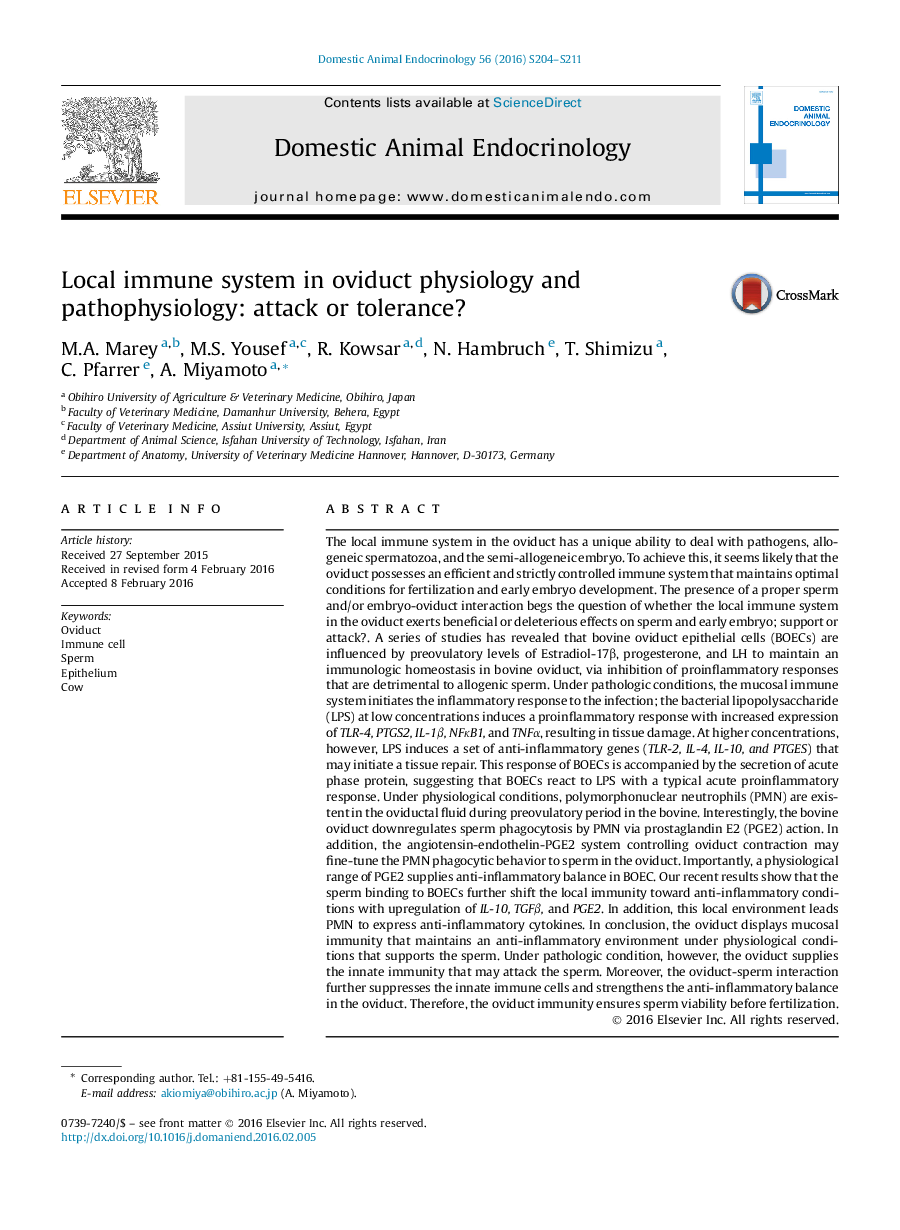| کد مقاله | کد نشریه | سال انتشار | مقاله انگلیسی | نسخه تمام متن |
|---|---|---|---|---|
| 10961157 | 1101316 | 2016 | 8 صفحه PDF | دانلود رایگان |
عنوان انگلیسی مقاله ISI
Local immune system in oviduct physiology and pathophysiology: attack or tolerance?
دانلود مقاله + سفارش ترجمه
دانلود مقاله ISI انگلیسی
رایگان برای ایرانیان
کلمات کلیدی
موضوعات مرتبط
علوم زیستی و بیوفناوری
علوم کشاورزی و بیولوژیک
علوم دامی و جانورشناسی
پیش نمایش صفحه اول مقاله

چکیده انگلیسی
The local immune system in the oviduct has a unique ability to deal with pathogens, allogeneic spermatozoa, and the semi-allogeneic embryo. To achieve this, it seems likely that the oviduct possesses an efficient and strictly controlled immune system that maintains optimal conditions for fertilization and early embryo development. The presence of a proper sperm and/or embryo-oviduct interaction begs the question of whether the local immune system in the oviduct exerts beneficial or deleterious effects on sperm and early embryo; support or attack?. A series of studies has revealed that bovine oviduct epithelial cells (BOECs) are influenced by preovulatory levels of Estradiol-17β, progesterone, and LH to maintain an immunologic homeostasis in bovine oviduct, via inhibition of proinflammatory responses that are detrimental to allogenic sperm. Under pathologic conditions, the mucosal immune system initiates the inflammatory response to the infection; the bacterial lipopolysaccharide (LPS) at low concentrations induces a proinflammatory response with increased expression of TLR-4, PTGS2, IL-1β, NFκB1, and TNFα, resulting in tissue damage. At higher concentrations, however, LPS induces a set of anti-inflammatory genes (TLR-2, IL-4, IL-10, and PTGES) that may initiate a tissue repair. This response of BOECs is accompanied by the secretion of acute phase protein, suggesting that BOECs react to LPS with a typical acute proinflammatory response. Under physiological conditions, polymorphonuclear neutrophils (PMN) are existent in the oviductal fluid during preovulatory period in the bovine. Interestingly, the bovine oviduct downregulates sperm phagocytosis by PMN via prostaglandin E2 (PGE2) action. In addition, the angiotensin-endothelin-PGE2 system controlling oviduct contraction may fine-tune the PMN phagocytic behavior to sperm in the oviduct. Importantly, a physiological range of PGE2 supplies anti-inflammatory balance in BOEC. Our recent results show that the sperm binding to BOECs further shift the local immunity toward anti-inflammatory conditions with upregulation of IL-10, TGFβ, and PGE2. In addition, this local environment leads PMN to express anti-inflammatory cytokines. In conclusion, the oviduct displays mucosal immunity that maintains an anti-inflammatory environment under physiological conditions that supports the sperm. Under pathologic condition, however, the oviduct supplies the innate immunity that may attack the sperm. Moreover, the oviduct-sperm interaction further suppresses the innate immune cells and strengthens the anti-inflammatory balance in the oviduct. Therefore, the oviduct immunity ensures sperm viability before fertilization.
ناشر
Database: Elsevier - ScienceDirect (ساینس دایرکت)
Journal: Domestic Animal Endocrinology - Volume 56, Supplement, July 2016, Pages S204-S211
Journal: Domestic Animal Endocrinology - Volume 56, Supplement, July 2016, Pages S204-S211
نویسندگان
M.A. Marey, M.S. Yousef, R. Kowsar, N. Hambruch, T. Shimizu, C. Pfarrer, A. Miyamoto,